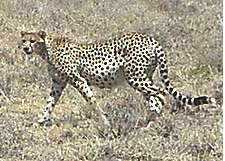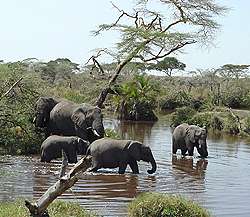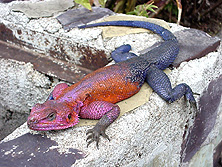Swahili for “endless plains,”ť Serengeti is the southern, Tanzanian, continuation of Kenya’s Masai Mara and, together with it, creates the scene of the annual clockwise foraging journeys of gnu and zebra known as The Migration. For 5,700 square miles Serengeti is home to prey (zebra, gun, gazelle and antelope) and predator (lion, leopard, cheetah, jackal and hyena), in fact this may be the best place in Africa to see lion. Ground
travel to the Serengeti is from the Ngorongoro Conservation Area
(the north border with Kenya’s Masai Mara has been closed by road
for some time now) and
as soon as you’ve left the volcanic highlands you know you’re in
a different world. We
weren’t 15 minutes into the park when our driver somehow spotted
movement maybe 500 yards ahead in the tall grass (driver guides have
exceptional vision – it took us several minutes to see what he was
looking at even after it was pointed out).
A mother cheetah with four young, maybe month-old cubs, was
beginning her hunt. She
moved swiftly, soundlessly, ignoring us but totally focused on a
tiny band of gazelles further on.
Not wanting to disrupt her concentration we held back. Cheetahs work hard for each meal, only eating what they’ve
killed, and this young mother had a larger than usual litter.
|

 Possibly
the best known game park in the world, the Serengeti IS “Africa”ť
to many, many people.
Possibly
the best known game park in the world, the Serengeti IS “Africa”ť
to many, many people. Crossing into the park through the Naabi Hill Gate the
koppis (or kopjes) pop out at you almost immediately.
Crossing into the park through the Naabi Hill Gate the
koppis (or kopjes) pop out at you almost immediately. As we turned to drive away, we surprised a Kori bustard,
Africa’s largest bird that can fly, who was airborne in just a few
short strides.
As we turned to drive away, we surprised a Kori bustard,
Africa’s largest bird that can fly, who was airborne in just a few
short strides.